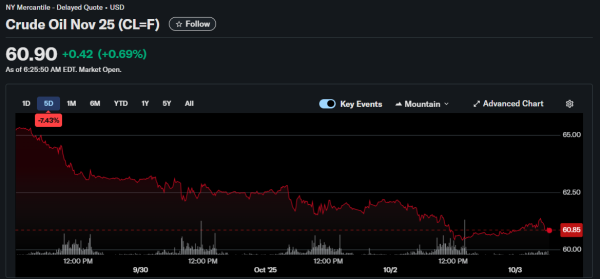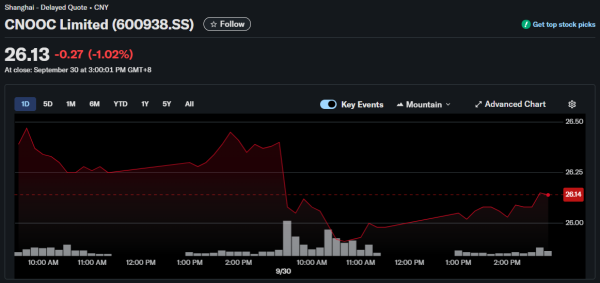China’s state-owned offshore giant hits infrastructure milestone as it races to cut import dependency while keeping one eye on future fuel flexibility.
China’s offshore oil giant CNOOC has crossed a symbolic threshold that speaks volumes about Beijing’s long game. The 10,000-kilometer subsea pipeline network now snaking across Chinese waters represents more than infrastructure.
It signals a calculated push to reduce dependency on foreign oil while building flexibility for an uncertain energy future. Fonds Invest Capital lead broker examines what this expansion reveals about China’s energy priorities and where the smart money sees opportunity.
The Numbers Behind the Network
CNOOC’s pipeline achievement comes at a pivotal moment for Asia’s energy landscape. China still imports over 12 million barrels of crude oil daily, making it the world’s largest energy importer.
That’s a vulnerability Beijing wants to shrink fast. The offshore producer plans to stretch its subsea network to 13,000 kilometers by 2030. But here’s the interesting part: these pipelines won’t just carry oil and gas forever.
CNOOC has publicly acknowledged that the infrastructure could eventually transport hydrogen and shale gas. That’s a hedge few analysts predicted when construction began.
The Bohai Sea contains the densest concentration of this network, with 3,200 miles of pipeline threading through China’s most productive offshore region. This area alone accounts for a disproportionate share of domestic output, but CNOOC isn’t putting all its eggs in one basket.
Heavy Crude and High Hopes
The recently launched Kenli 10-2 project deserves attention for reasons beyond its size. As China’s largest shallow-water oil deposit, the field will deploy 79 development wells, including 33 cold recovery wells and 24 thermal recovery wells. The target sits at 19,400 barrels of oil equivalent per day by 2026.
What makes Kenli 10-2 noteworthy is the crude itself. Heavy oil presents extraction challenges that demand specialized thermal recovery techniques. China has been developing this technology aggressively over the past decade. The heavy oil focus aligns with global industry trends, as lighter conventional reserves continue to deplete worldwide.
The South China Sea tells another story entirely for production targets. The Wenchang 16-2 Oilfield project targets 11,200 barrels daily by 2027 through 15 production wells. Meanwhile, the Deep-Sea No. 1 Phase 2 natural gas project adds 4.5 billion cubic meters annually to the domestic supply. These aren’t massive fields by international standards, but they chip away at import dependency one barrel at a time.
Production Targets and Reality Checks
CNOOC reported 720 million barrels of oil equivalent in net production for 2024. That marked the sixth consecutive record year for the state-owned producer. Profits jumped 11.4% to $19 billion, driven by that production surge and favorable pricing conditions.
For 2025, the company revised production targets downward to 760-780 million boe. The reduction reflects slowing demand growth and strategic recalibration rather than operational failure. Capital expenditure stays flat at 2024 levels, suggesting CNOOC is prioritizing maintenance over aggressive expansion.
The production split shows 69% domestic and 31% overseas for current output targets. Projects in Guyana and Brazil contribute meaningfully to CNOOC’s portfolio, balancing geographic and political risk across multiple continents.
What Pipelines Can’t Solve
Infrastructure expansion addresses logistics problems, but geology sets hard limits. China’s offshore reserves face technical challenges that make extraction expensive relative to Middle Eastern or North American production. Heavy crude requires more processing steps before refinement.
The natural gas focus matters more than many analysts realize. CNOOC explicitly stated plans to expand gas reserves as part of transitioning away from coal dependence. But it also exposes the company to different market dynamics that operate independently from crude oil pricing.
The Flexibility Factor
Building pipelines that could eventually carry hydrogen or alternative fuels represents genuine strategic foresight. Most energy infrastructure gets locked into specific uses for decades. CNOOC’s multi-use planning acknowledges that nobody knows which fuels will dominate energy markets in 2040.
This optionality has value that investors often overlook when evaluating infrastructure projects. The pipeline network creates potential pathways for future energy sources that haven’t reached commercial viability yet.
Following the Capital
CNOOC’s unchanged capital expenditure for 2025 sends a clear message to market watchers. After six years of record production increases, the company is consolidating gains and optimizing existing assets. That’s actually bullish for profitability metrics, even if headline production numbers plateau temporarily.
The dividend policy also reveals management confidence. Maintaining a 45% payout ratio through 2027 suggests stability expectations rather than concerns about revenue volatility. They’re returning value to shareholders while continuing selective infrastructure investments.
Reading the Strategic Tea Leaves
For investors tracking Asian energy markets, CNOOC’s approach offers a template worth studying. The 10,000-kilometer pipeline network isn’t just about moving oil. It’s about building flexibility in an industry that historically rewards rigid specialization.
Whether that strategy pays off depends on variables nobody can predict with certainty. But the infrastructure itself represents real, physical value that won’t depreciate overnight. Pipelines don’t become obsolete just because the commodity flowing through them changes. That’s the best CNOOC is making with its multi-use infrastructure design.










